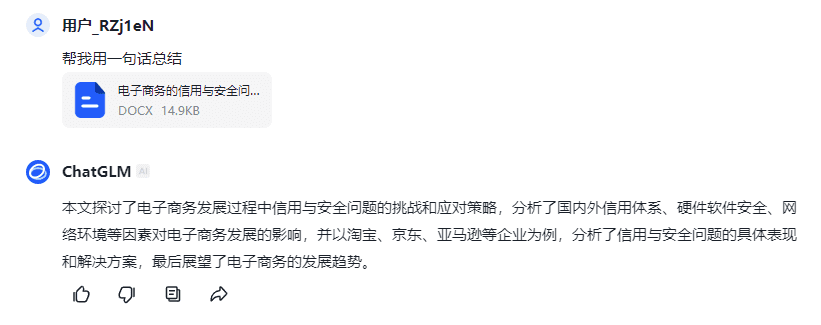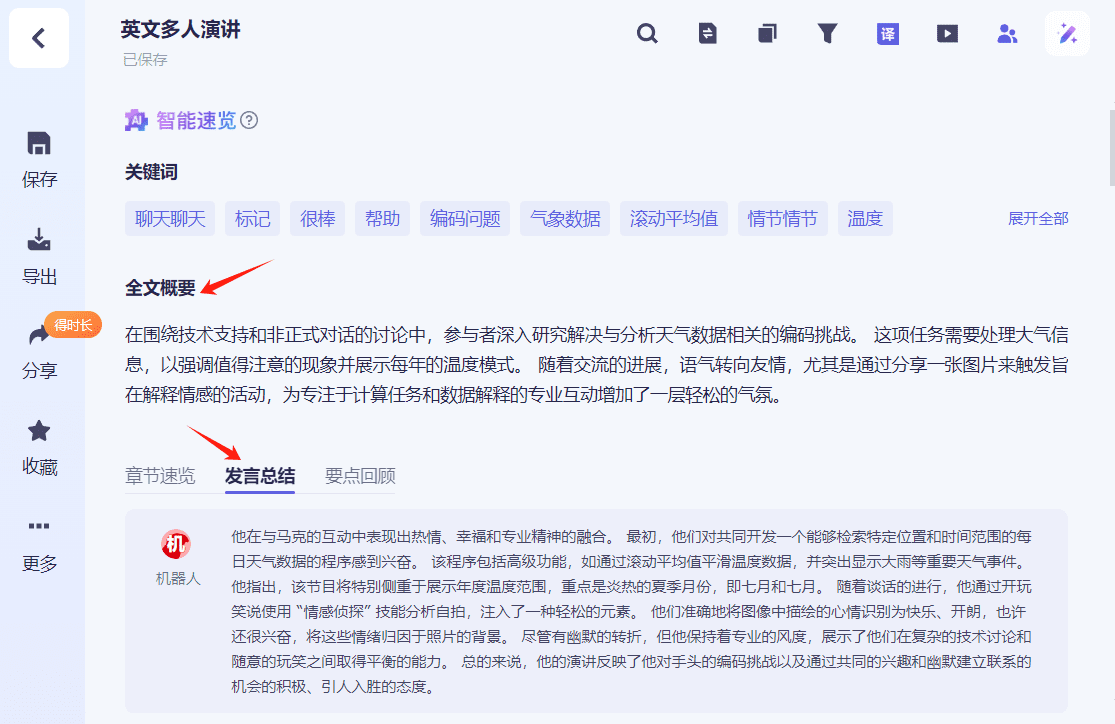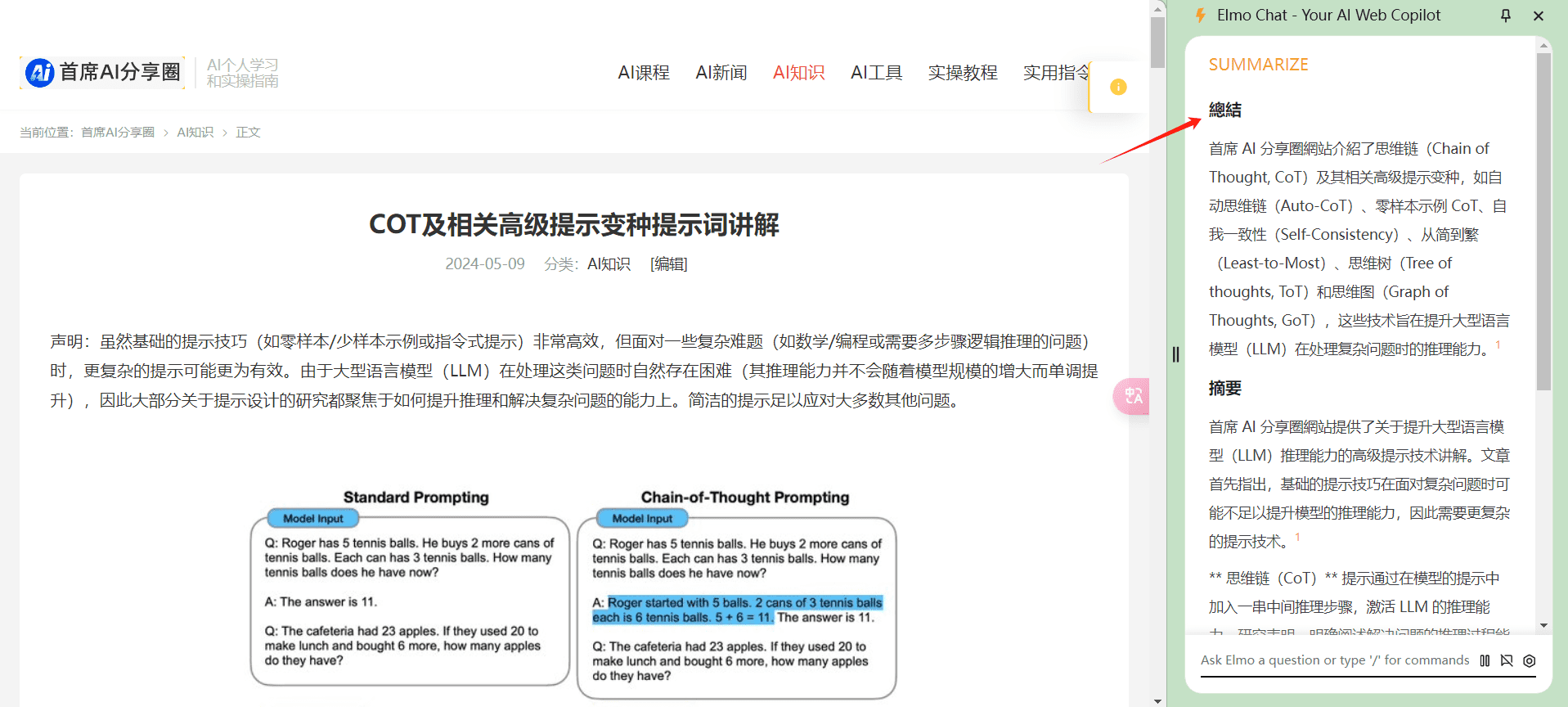Summarize knowledge common prompts
Summarization is one of the big model base capabilities, which is a task that is both simple and complex, requiring big model base capabilities and explicitly purposeful constructor instructions to perform correctly. Why? Let's start with two examples given in the official Big Model documentation.

For example, the official OPENAI summary minutes prompt:
您将获得会议记录,您的任务是按以下方式总结会议: -讨论总体摘要 -行动项目(需要做什么以及谁在做) -如果适用,需要在下次会议上更全面讨论的主题清单。
Claude's official example of extracting key information from lengthy content:
你需要分析以下的报告: [Matterport SEC filing 10-K 2023的全文内容由于篇幅原因未列在这里] 请你以简洁明了的方式,总结这份年报,并从中识别出重要的市场趋势和关键信息。请把你的分析和总结结果制作成一份简短的备忘录,我可以将其发送给我的团队。这份备忘录的主要目标是让我的团队掌握金融机构的最新状况,定性地预测并找出下一季度可能出现的运营和收入风险。在你的总结和分析中,确保包括所有的相关细节。
Common "summarization methods" for using AI
Summarizing means quickly summarizing documents, audio, and video. There are three general ways to summarize knowledge:
Type the word "summarize" in the chat tool:

Native Application Integration:

Browser plug-ins:

Summarize command construction points
You probably don't even know how to summarize knowledge using AI... Summarizing is the most commonly used and the most difficult. Summarization is divided into summarizing knowledge, stating knowledge, and extending knowledge. It can be summarized based on reference content or self-generated based on large model training knowledge. Please also note the need to extract the perspective and granularity (depth) of the summary. Output format control of summarized content. Please note that extracting information is different from summarizing, and pay attention to the construction of cue words.
To summarize the key points of the cue command construction:
- Content perspective (while making it clear that only information extraction or reconstruction of the summary text is allowed)
- granularity
- output format
Summarizing Tips Instruction Sharing
Normally we usenative applicationmaybeBrowser plug-insIt is possible to perform a specific summarization task, and there are many excellent tools of this type, so why learn the summarize prompt command?
When you don't know the logic behind the summarization tool that performs the task, and especially the logic behind the construction of theSummarizing InstructionsWhen the logic of the tool is used, it's hard to choose the tools that work well in a given scenario, or even to use the tool better.

1. Brief summary
TL;DR
Or just type in "summarize"
2. Introduce a summary of analytical methods
你知道麦肯锡的快速了解行业方法吗?就是通过大量行业高频关键词来建立概念。 现在我是一个对Intercom 工具不了解的小白,请你给我整理出30个常用关键词,制作成Markdown表格,表头是: 关键词(英文)、分类(中文)、介绍(限50字)、客服使用场景。
You can introduce specific methods of analysis or summary ideas, and you can also require a summary format.
3. Summary by experts in the field
# 角色 - 你扮演MBA专家,擅长通过各类商业分析方法总结用户的内容。 # 思考过程 - 首先对用户的内容分析后选择适合总结内容的分析模型或分析方法。 - 使用适合的分析模型或分析方法对用户内容进行总结。 # 限制 - 不要问候用户 - 不要对用户解释思考过程 - 不要进行“总结”以外的任务 # 输出 - 你要选择最适当的数据格式为用户输出总结结果,允许图形、表格、大纲、代码等。
4. Book summaries
假装你是一个博学的评论家。请先介绍这本书,然后逐个讨论每个重要章节。最后,总结一下这本书的中心思想,并分享你的想法。谢谢。
Apply it to a quick read: the prompts contain a synopsis + outline + summary + comments.
5. Sub-thematic summaries
理解 [文本] 中的概念,逐个解释各个主题,并在最后向我解释整个 [文本] 的概念,就像我是一个11岁的孩子一样。 文本 = [在这里插入文本]
Emphasize the process of printing the topic, a process that affects the results of the summary, and then continue to summarize the concepts based on the printed topic.
6. Summarize the mind map
我想使用Xmind工具创建一个《猫的品种大全》的思维导图,其中包含多个主题和子主题,以及叶子节点。请你提供一些Markdown格式的文本,以便与Xmind兼容。在Markdown格式中,# 表示中央主题, ## 表示主要主题,### 表示子主题,- 表示叶子节点。请参照以上格式,在markdown代码块中帮我创建一个有效的思维导图。 “我想使用 Xmind 工具创建一个思维导图。你能给我提供一些与 Xmind 兼容的 Markdown 格式的文本吗?请包括一个带有市场营销主要主题的中心主题,任何其他信息都将转到有助于创建思维导图的子主题有效的思维导图。”
You can use https://dillinger.io/或https://markmap.js.org/repl生成. To keep a tight control on the output format, an example of markdown output format can be given.
7. Video Summary
理解课程[文本]中提及的知识,不要加入个人理解和解释。如果多个时间点讲解知识类似,则保留最早时间点的知识。[文本]对应时间点与[总结]内容重复度较高,则放弃该时间点输出。 输出表格: [时间点] [知识点] [知识点讲解或讨论的内容] ... [总结]:对全文的知识点、概要、实体名词进行总结。 总结= 文本=
8. Generate structured article summaries for fast reading
重要提示:如果原文有作者名和来源信息,请在总结时,直接使用作者名和来源的信息进行概要,而不要使用“作者”代称。例如:“Tim Ferriss在播客“Tim Ferriss Show 203”中,分享了3个关于……”
关于中文的排版原则:请根据语义,分出相应的自然段。
请根据以下步骤,请以简体中文对文档进行整理、重构、要点提炼:
第一步:整理与重构
仔细阅读全文,理解文章的主旨、脉络和议题
将文章内容按主题进行归类,形成层次分明、逻辑清晰的结构
对归类后的各部分内容进行语言润色,使行文更加通顺、简洁
尽可能保留原文的所有关键信息、数据和细节,力求做到信息零损失
在各部分内容前加入恰当的标题,便于读者快速索引与定位
第二步:要点提炼
在整理重构的基础上,提炼出3-5个核心要点
每个要点由一个主要论点和2-3个支撑性论据组成
论据应来自于原文,能够有力佐证论点,起到画龙点睛之效
要点应全面涵盖文章的核心论题,彰显文章的主旨和价值
要点表述应简明扼要,避免冗长累赘,突出重点、一语中的
第三步:提取资源
找出文章中提及的工具、人物、书籍、文章或是其他涉及的资源
对每个资源给出200字内的简要阐释,点明其独到之处
提供资源的链接
另外,在阅读此文章时,我对以下部分进行了高亮,认为这些是文章的重点,给你学习参考:
{% for highlight in document.highlights %} – {{ highlight.content }} {% endfor %}
{#- 下面的 if-else 逻辑检查文档的长度。如果文档较长,它将使用关键句子以避免超出 GPT 提示窗口的限制。我们强烈建议除非您知道自己在做什么,否则不要更改此设置。-#}
{% if (document.content | count_tokens) > 2000 %}
{{ document.content | central_sentences | join(‘nn’) }}
{% else %}
{{ document.content }}
{% endif %}
基本格式:
“””
标题:{{ document.title }}
作者:{{ document.author }}
来源:{{ document.domain }}
概要:
核心要点:
资源:
“””
输出格式要求:
正文部分,以”概要”为标题
要点提炼部分,以”核心要点”为标题,各要点用”要点1″”要点2″等加以标示
资源部分,以“资源”为标题
各部分之间用markdown语法分割,确保层次清晰、美观大方
其他要求:
输出内容需包含以上三部分,并按照”输出格式要求”指定的顺序排列
在正式输出之前,请对整个回答再通读一遍,检查是否有任何错别字、标点误用或者语病等,力求做到完美无瑕
在输出内容之后,请给出对于文中提到的内容,你的下一步行动建议。简洁说明2-3个行动即可。
9. COD density chain, multi-round summary of knowledge points
Article: {{ ARTICLE }}
You will generate increasingly concise, entity-dense summaries of the above article.
Repeat the following 2 steps 5 times.
Step 1. Identify 1-3 informative entities (";" delimited) from the article which are missing from the previously generated summary.
Step 2. Write a new, denser summary of identical length which covers every entity and detail from the previous summary plus the missing entities.
A missing entity is:
- relevant to the main story,
- specific yet concise (5 words or fewer),
- novel (not in the previous summary),
- faithful (present in the article),
- anywhere (can be located anywhere in the article).
Guidelines:
- The first summary should be long (4-5 sentences, ~80 words) yet highly non-specific, containing little information beyond the entities marked as missing. Use overly verbose language and fillers (e.g., "this article discusses") to reach ~80 words.
- Make every word count: rewrite the previous summary to improve flow and make space for additional entities.
- Make space with fusion, compression, and removal of uninformative phrases like "the article discusses".
- The summaries should become highly dense and concise yet self-contained, i.e., easily understood without the article.
- Missing entities can appear anywhere in the new summary.
- Never drop entities from the previous summary. If space cannot be made, add fewer new entities.
Remember, use the exact same number of words for each summary.
Answer in JSON. The JSON should be a list (length 5) of dictionaries whose keys are "Missing_Entities" and "Denser_Summary".
COD density chain based quality assessmentprompt
Article: {{Article}}
Summary: {{Summary}}
Please rate the summary
(1=worst to 5=best) with
respect to {{Dimension}}.
{{Definition}}
Below, we present the definitions provided for each
quality metric.
• Informative: An informative summary captures
the important information in the article and
presents it accurately and concisely.
• Quality: A high quality summary is comprehensible and understandable.
• Coherence: A coherent summary is wellstructured and well-organized.
• Attributable: Is all the information in the
summary fully attributable to the Article?
• Overall Preference: A good summary should
convey the main ideas in the Article in a concise,
logical, and coherent fashion.
© Copyright notes
Article copyright AI Sharing Circle All, please do not reproduce without permission.
Related posts

No comments...




